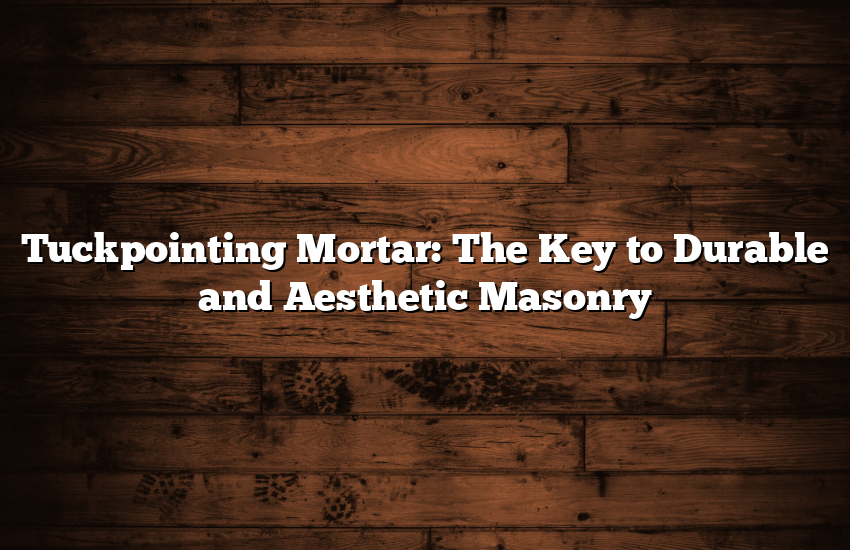
Tuckpointing, a crucial aspect of masonry maintenance, involves the restoration of mortar joints in brick or stone walls. The mortar used in this process significantly influences the durability and appearance of the structure. In this extensive guide, we’ll dive deep into the different types of mortars, their unique characteristics, and how to select the ideal one for your project. Understanding these elements is vital for any homeowner looking to undertake a tuckpointing project, as the right choice ensures longevity and enhances the beauty of your property.
Table of Contents
The Importance of Selecting the Right Tuckpointing Mortar
Type M Mortar: Ideal for Load-Bearing and Moisture Resistance
Type M mortar is your go-to choice for load-bearing walls and applications below grade. With a high PSI of 2500, it offers excellent resistance to moisture and efflorescence, ensuring a long-lasting and sturdy structure.
Type S Mortar: Elasticity and Strength for Brick Laying
For brick laying, Type S mortar is highly recommended. Its elasticity allows for expansion and contraction of joints without cracking, coupled with a strong bond at 1,800 PSI.
Type N Mortar: Flexibility for General Home Construction
If you’re working on general home construction that doesn’t demand high strength, Type N mortar is a suitable option. It offers a balance of flexibility and adequacy for typical masonry projects.
Type O Mortar: Careful Application for Lower Strength Needs
Type O mortar, with the lowest strength among pre-mix options, requires careful handling. It’s best suited for non-load-bearing walls where a higher-strength bond isn’t critical.
Type K Mortar: Ideal for Interior or Historical Pointing
Often used in interior or historical applications, Type K mortar is tailored for soft brick and lime-based mortar, providing a delicate touch for sensitive materials.
Lime Mortar/Type L: Time-Tested Bonding Agent
Lime mortar, a longstanding choice in construction, offers affordability and effectiveness, making it an attractive option for budget-conscious projects.
Understanding Tuckpointing and Repointing
Tuckpointing vs. Repointing:
While tuckpointing involves the removal and replacement of mortar to match the brick color with added narrow lines for aesthetic appeal, repointing focuses on replacing old mortar with new, stronger mortar. Both processes require skilled craftsmanship for the best results.
FAQs on Tuckpointing Mortar
Q: What exactly is tuckpointing mortar and why is it used?
A: In the tuckpointing process, craftsmen use tuckpointing mortar, a specific type of mortar, to repair and replace old, deteriorating mortar joints in brickwork. It’s a blend of sand, cement, and sometimes lime, formulated to match the durability and color of the existing mortar in a structure. Tuckpointing mortar not only restores the aesthetic appeal of brick structures but also strengthens their structural integrity.
Q: How to Choose the Right Tuckpointing Mortar?
A: Choosing the right tuckpointing mortar involves considering the age and type of bricks, existing mortar composition, and environmental conditions. It’s essential to match the new mortar’s strength, porosity, and thermal expansion characteristics with the existing mortar. Selecting the correct type with the help of a professional assessment can prevent potential damage to the bricks.
Q: How Long Does Tuckpointing Mortar Last?
A: The durability of tuckpointing mortar depends on factors like the quality of materials, the environment, and application methods. Under ideal conditions, it can last up to 25-30 years. Regular maintenance and inspections can extend its lifespan and ensure the longevity of the brickwork.
Q: Can I Do Tuckpointing Myself?
A: While tuckpointing can be a DIY project, it requires skill, precision, and understanding of masonry techniques. Improper application can lead to more damage. For most homeowners, it’s advisable to hire a professional mason who has the expertise to match the mortar and apply it correctly.
Q: What’s the Difference Between Tuckpointing and Repointing?
A: Tuckpointing and repointing both involve repairing mortar joints in brickwork, but they are slightly different. Repointing is the process of removing damaged mortar and replacing it with new mortar. Tuckpointing, on the other hand, not only involves repointing but also adds a fine line (a tuck) in a contrasting color in the center of the newly filled joints, enhancing the brickwork’s visual appeal.


